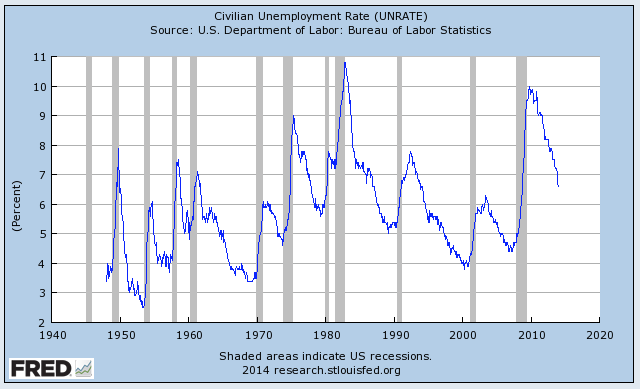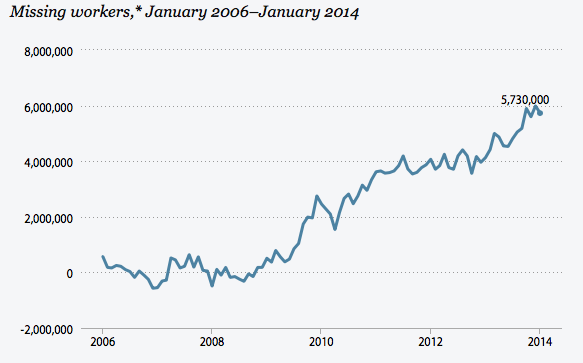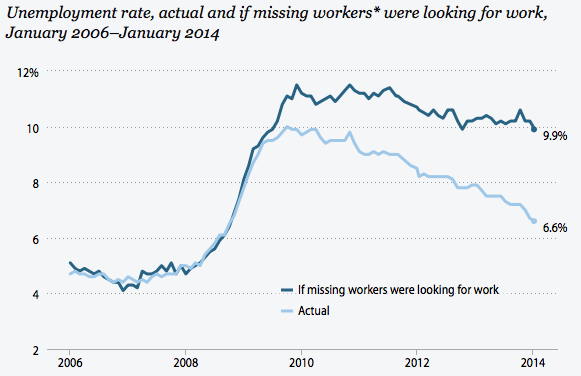Let's open this posting by looking at a graph from FRED showing what has happened to the unemployment rate since record-keeping began in 1948:
There is no doubt that the recovery in employment since the depths of the Great Recession has been rather stunning, dropping from a peak of 10 percent in October 2009 to its current level of 6.6 percent. However, as you can readily see on the graph, the rate is still between 1.5 and 2 percentage points higher than the lows normally seen during a recovery and, in fact, the current rate is still nearly a percentage point higher than the 65 year average of 5.8 percent through both recessions and recoveries.
Unfortunately, as Dr. Heidi Shierholz, an economist with the Economic Policy Institute notes, most of the improvement in America's unemployment rate has been for the wrong reasons, largely because the current method of calculating the rate vastly understates the problem.
Here is how the Bureau of Labor Statistics defines unemployment:
"Persons are classified as unemployed if they do not have a job, have actively looked for work in the prior 4 weeks, and are currently available for work. Actively looking for work may consist of any of the following activities:
Contacting an employer directly or having a job interview
Contacting a public or private employment agency
Contacting friends or relatives
Contacting a school or university employment center
Sending out resumes or filling out job applications
Placing or answering advertisements
Checking union or professional registers
Some other means of active job search
Passive methods of job search do not have the potential to result in a job offer and therefore do not qualify as active job search methods. Examples of passive methods include attending a job training program or course, or merely reading about job openings that are posted in newspapers or on the Internet.
Workers expecting to be recalled from temporary layoff are counted as unemployed, whether or not they have engaged in a specific jobseeking activity. In all other cases, the individual must have been engaged in at least one active job search activity in the 4 weeks preceding the interview and be available for work (except for temporary illness)."
Basically, if you haven't looked for work in the four weeks prior to the BLS survey, you drop off their radar and are not considered "unemployed". Quite often, these workers are not looking for work because job opportunities do not exist and can be termed as "missing workers".
Dr. Shierholz notes that estimating the number of missing workers is not easy, largely because changes in America's labor force participation rate have nothing to do with the weak jobs market. One example of this is the growing number of baby boomers who are reaching retirement age and permanently leaving the labor force (although some economists suggest that this factor is not having as significant an impact on labor force participation as one might think). By using labor force projections from the 2007 BLS publication "Labor force projections to 2016: more workers in their golden years", one can get a sense of where the labor force participation rate would have been heading based on retiring baby boomers alone (i.e. structural changes in the size of the labor force). Using the difference between these projections and the current labor force participation rate data, one can calculate the cyclical change (drop) in the labor force participation rate that is due to the weak labor market following the Great Recession. The size of the potential labor force is then calculated by multiplying the current month's structural labor force participation rate by the actual population numbers and then subtracting the actual size of the labor force, thus yielding the number of "missing workers".
In January 2014, the 5,730,000 "missing workers" were composed of the following:
Men under 25 years of age: 960,000
Men 25 to 54 years of age: 1,650,000
Men over 55 years of age: 640,000
Women under 25 years of age: 400,000
Women 25 to 54 years of age: 1,170,000
Women over 55 years of age: 910,000
Here is a graph showing how the official U-3 unemployment rate is significantly understating the scale of America's unemployment problems when the missing workers are added to the BLS-defined unemployed:
The unemployment rate takes a substantial jump from what appears to be a reasonably healthy 6.6 percent to 9.9 percent. As well, it is quite apparent that the recovery in the unemployment rate when "missing workers" are included is not nearly as substantial since the end of the Great Recession as it is in the case of the U-3 statistics. When "missing workers" are included, the peak unemployment rate hit 11.5 percent in December 2009 and November 2010 (compared to 9.9 percent and 9.8 percent U-3 respectively) and has only dropped 1.6 percentage points to its current level. This compares to a 3.4 percentage point drop in the headline U-3 unemployment rate. In other words, Ben Bernanke's experiment has more or less been a total dud.
As we can clearly see, the headline monthly U-3 rate is misleading non-thinkers and the mainstream media into believing that the U.S. economy really is on the mend. In fact, it is the confluence of several factors that are "conspiring" to artificially suppress the unemployment rate. Economic reality is far more painful, as millions of Americans can attest.
Click HERE to read more of Glen Asher's columns
You can publish this article on your website as long as you provide a link back to this page.




Be the first to comment